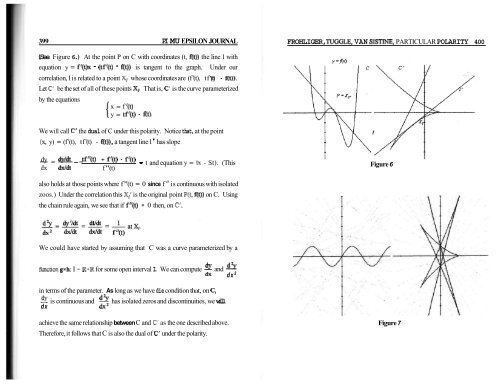397 PI MU EPSILON JOURNALy = ax - b . <strong>No</strong>w the line corresponding to a point R(t, at - b) on lp has theequation y = tx - (at - b); consequently, this line passes through P. Similarly,it can be shown that every nonvertical line through P corresponds to a point on lp.FROHLIGER, TUGGLE, VAN SISTINE, PARTICULAR POLARITY 398donned into one pencil of lines in a projective fashion. It follows then that thepoints on every line are mapped to the corresponding pencil in a projectivefashion. (See [I], page 57.) In our case, we will use the x-axis as the line &d thelines through the origin as the corresponding pencil. Let li and li be the y-axisand the line y = 1, respectively, and let Ol and 0, be the points (1,l) and (1,O).(See Rgure 5.) One can easily see that, for a * 0, 1 , a point (a, 0) is projectedthrough Ol to the point (0, a/(a - 1))on li and this point is projected through 0,to the point (11% 1)on 1,. Finally, the line through this point and the origin is theline y = ax - 0, the image of (a, 0) under the correlation.Figure 4In projective geometry, a transformation such as ours, which takes points to linesand lines to points, is called a correlation if it preserves incidence. That is, ifpoint P is on line I, then under a correlation the point corresponding to i would beon the line corresponding to P. We can extend our correlation to the extendedEuclidean plane , which contains ideal as well as ordinary points and lines, byhaving the vertical line x = a correspond to the ideal point associated with thebundle of parallel lines with slope a and having the ideal line correspond to theideal point associated with the bundle of vertical lines. With this new, expandeddefinition, the next property shows that our correlation is a special type oftransformation called a polarity. Readers unfamiliar with projective geometrymay wish to skip the property and its proof.Property 3: This correlation is projective with period 2; hence, it is a polarity.Proof: To prove this, we need only show that the points on one line areFigure 5Using ideal points, one can easily see that this projectivity takes the point (0,O) tothe x-axis and the point (1,O) to the line y = x.It is easy to see that the correlation has period 2. It follows from Property 3 that,I if point P is transformed into line lp then lp is transformed into P.IDUAL CURVES INDUCED BY THE POLARITYLet I be an open interval on the real line and ex) be a function on I whose secondderivative is continuous with isolated zeros. Let C be the graph off.
399 PI MU EPSILON JOURNAL FROHLIGER, TUGGLE, VAN SISTINE, PARTICULAR POLARITY 400(See Figure 6.) At the point P on C with coordinates (t, fft)) the line 1 withequation y = fJ(t)x - (tfJ(t) - St)) is tangent to the graph. Under ourcorrelation, 1 is related to a point X, whose coordinates are (f '(t), t f '(t)- f(t)).Let C' be the set of all of these points Xi. That is, C' is the curve parameterizedby the equationsx = f '(I)y = tfl(t) - St).We will call C' the dual of C under this polarity. <strong>No</strong>tice that, at the point(x, y) = (f '(t), t f '(t) - f(t)), a tangent line 1 ' has slopedy _ dy/dt - tfl'(t) + fJ(t) - fJ(t) - ---- - t and equation y = tx - St). (Thisdx dddt f "(t)Figure 6also holds at those points where f "(t) = 0 since f " is continuous with isolatedzoos.) Under the correlation this X i is the original point P(t, Rt)) on C. Usingthe chain rule again, we see that if fl'(t) * 0 then, on C',We could have started by assuming that C was a curve parameterized by afinBtion gxh: I - RxR for some open interval I. We can compute and - d^dx dx 2in terms of the parameter. As long as we have die condition that, on C,dyd^dxdx2- is continuous and - has isolated zeros and discontinuities, we willachieve the same relationship between C and C' as the one described above.Therefore, it follows that C is also the dual of C' under the polarity.Figure 7
- Page 2 and 3: - Another Matching Problem with aMa
- Page 4 and 5: Red Light, Green Light:A Model of T
- Page 6 and 7: BENNINK. RED LIGHT, GREEN LIGHT 357
- Page 8 and 9: BENNINK, RED LIGHT, GREEN LIGHT 361
- Page 10 and 11: 365 PI MU EPSILON JOURNALROUSSEAU,
- Page 12 and 13: 369 PI MU EPSILON JOURNALwe havec(n
- Page 14 and 15: 3 73 PI MU EPSILON JOURNALThis can
- Page 16 and 17: VIAR, DIMENSION FORMULA 377subspace
- Page 18 and 19: TOMFORDE, SELF-SIMILARITY 38 1m, n
- Page 20 and 21: TOMFORDE, SELF-SIMILARITY 385Note t
- Page 22 and 23: TOMFORDE, SELF-SIMILARITY 3 896. G.
- Page 24 and 25: 393 PI MU EPSILON JOURNALA Particul
- Page 28 and 29: 40 1 PI MU EPSILON JOURNALFigure 8P
- Page 30 and 31: The Power Means Theorem via the Wei
- Page 32 and 33: MISCELLANY 409The 1995 GameIn die F
- Page 34 and 35: 0. Co-author of convexity theoremP.
- Page 36 and 37: Pi MU EPSILON JOURNALii) JK is para
- Page 38 and 39: PROBLEMS AND SOLUTIONS 42 1Henry S.
- Page 40 and 41: PROBLEMS AND SOLUTIONS 425865. [Fal
- Page 42 and 43: PROBLEMS AND SOLUTIONS 429868. [Fal
- Page 44 and 45: BENNINK, RED LIGHT, GREEN LIGHT 3 6
- Page 46 and 47: PROBLEMS AND SOLUTIONS 437Solution
- Page 48 and 49: Editor's NoteThe Pi Mu Epsilon Jour
















